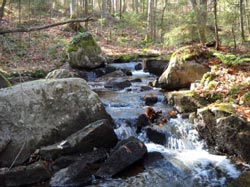Wetlands could be key in revitalizing acid streams, UT Arlington researchers say

A team of UTA biologists analyzed water samples in the Adirondack Forest Preserve.<br>
The group, led by associate professor of biology Sophia Passy, also contends that recent increases in the level of organic matter in surface waters in regions of North America and Europe – also known as “brownification” – holds benefits for aquatic ecosystems.
The research team’s work appeared in the September issue of the journal Global Change Biology.
The team analyzed water samples collected in the Adirondack Forest Preserve, a six million acre region in northeastern New York. The Adirondacks have been adversely affected by atmospheric acid deposition with subsequent acidification of streams, lakes and soils. Acidification occurs when environments become contaminated with inorganic acids, such as sulfuric and nitric acid, from industrial pollution of the atmosphere.
Inorganic acids from the rain filter through poorly buffered watersheds, releasing toxic aluminum from the soil into the waterways. The overall result is loss of biological diversity, including algae, invertebrates, fish, and amphibians.
“Ecologists and government officials have been looking for ways to reduce acidification and aluminum contamination of surface waters for 40 years. While Clean Air Act regulations have fueled progress, the problem is still not solved,” Passy said. “We hope that future restoration efforts in acid streams will consider the use of wetlands as a natural source of stream health improvement.”
Working during key times of the year for acid deposition, the team collected 637 samples from 192 streams from the Black and Oswegatchie River basins in the Adirondacks. Their results compared biodiversity of diatoms, or algae, with levels of organic and inorganic acids. They found that streams connected to wetlands had higher organic content, which led to lower levels of toxic inorganic aluminum and decreased presence of harmful inorganic acids.
Passy joined the UT Arlington College of Science in 2001. Katrina L. Pound, a doctoral student working in the Passy lab, is the lead author on the study. The other co-author is Gregory B. Lawrence, of the USGS’s New York Water Science Center.
The study authors believe that as streams acidified by acidic deposition pass through wetlands, they become enriched with organic matter, which binds harmful aluminum and limits its negative effects on stream producers. Organic matter also stimulates microbes that process sulfate and nitrate and thus decreases the inorganic acid content.
These helpful organic materials are also present in brownification – a process that some believe is tied to climate change. The newly published paper said that this process might help the recovery of biological communities from industrial acidification.
Many have viewed brownification as a negative environmental development because it is perceived as decreasing water quality for human consumption.
“What we’re saying is that it’s not entirely a bad thing from the perspective of ecosystem health,” Pound said.
The UTA team behind the paper hopes that watershed development, including wetland construction or stream re-channeling to existing wetlands, may become a viable alternative to liming. Liming is now widely used to reduce acidity in streams affected by acid rain but many scientists question its long-term effectiveness.
The new paper is available online at http://onlinelibrary.wiley.com/doi/10.1111/gcb.12265/abstract.
Funding for Passy’s work was provided in part by the New York State Energy Research and Development Authority. The Norman Hackerman Advanced Research Program, a project of the Texas Higher Education Coordinating Board, as well as the US Geological Survey, the Adirondack Lakes Survey Corporation and the New York State Department of Environmental Conservation also provided support.
The University of Texas at Arlington is a comprehensive research institution of more than 33,000 students and more than 2,200 faculty members in the heart of North Texas. Visit www.uta.edu to learn more.
The University of Texas at Arlington is an Equal Opportunity and Affirmative Action employer.
Media Contact
All latest news from the category: Ecology, The Environment and Conservation
This complex theme deals primarily with interactions between organisms and the environmental factors that impact them, but to a greater extent between individual inanimate environmental factors.
innovations-report offers informative reports and articles on topics such as climate protection, landscape conservation, ecological systems, wildlife and nature parks and ecosystem efficiency and balance.
Newest articles

A new look at the consequences of light pollution
GAME 2024 begins its experiments in eight countries. Can artificial light at night harm marine algae and impair their important functions for coastal ecosystems? This year’s project of the training…

Silicon Carbide Innovation Alliance to drive industrial-scale semiconductor work
Known for its ability to withstand extreme environments and high voltages, silicon carbide (SiC) is a semiconducting material made up of silicon and carbon atoms arranged into crystals that is…

New SPECT/CT technique shows impressive biomarker identification
…offers increased access for prostate cancer patients. A novel SPECT/CT acquisition method can accurately detect radiopharmaceutical biodistribution in a convenient manner for prostate cancer patients, opening the door for more…





















